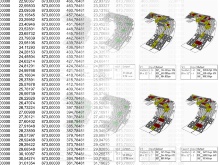Building Information Modelling (BIM)
Building Information Models are virtual architectural models, which, apart from the geometry, include information which is relevant for a planning process. Important components, such as geographic information, exposure analysis, mass calculations, cost parameters as well as planning details are embedded into a parametric model. The loss of information from design to construction is minimized and problems at the interfaces of different areas are quickly and easily uncovered.
Therefore, Building Information Models form a logical extension of digital representation models to planning tools that render and support the entire planning cycle of a project.
The aim of the seminar is to communicate the principles of information models and their potentials in a design and planning process. The seminar is structured in a theory and a practical part. The theoretical part aims to teach participating students the basic principles of BIM technology. In the practical part, students will work on exercises and a specific project using BIM software, such as Revit/Dynamo.
No previous knowledge is required.
Building Information Models are virtual architectural models, which, apart from the geometry, include information which is relevant for a planning process. Important components, such as geographic information, exposure analysis, mass calculations, cost parameters as well as planning details are embedded into a parametric model. The loss of information from design to construction is minimized and problems at the interfaces of different areas are quickly and easily uncovered.
Therefore, Building Information Models form a logical extension of digital representation models to planning tools that render and support the entire planning cycle of a project.
The aim of the seminar is to communicate the principles of information models and their potentials in a design and planning process. The seminar is structured in a theory and a practical part. The theoretical part aims to teach participating students the basic principles of BIM technology. In the practical part, students will work on exercises and a specific project using BIM software, such as Revit/Dynamo.
No previous knowledge is required.


